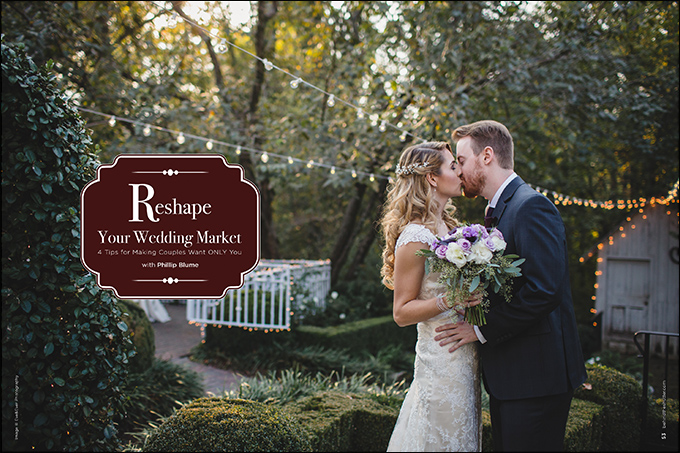Reshape Your Wedding Market: 4 Tips for Making Couples Want Only You with Phillip Blume
Want more information on this article? Get access to video content and additional supporting images. Launch the May issue of the magazine by logging in or signing up for a free account by clicking here. Shutter Magazine is the industry’s leading professional photography magazine.
It may be the most common complaint we hear from wedding photographers: “My market is just too cheap. No one’s willing to pay real money for photography.” It’s a frustrating feeling, and I’ve felt it, too. There’s no doubt photographers (and “faux-tographers”) are everywhere—entering and exiting our markets with bargain prices and shiny new cameras they got for Christmas. How can photographers like us, who want to run legitimate full-time businesses, ever compete?
Compete is the operative word, isn’t it? We all tend to obsess over, scope out and compare ourselves to “the competition.” For good reason…right? I mean, isn’t it basic supply and demand? We’re afraid too many photographers will drown out our voice, and there won’t be enough newly engaged couples to go around. If you’re dealing with meager bookings and high advertising costs right now, your fears will seem confirmed and reinforce this pessimistic narrative about the “bad” market.
I’d like to preach some good news to you a better-informed narrative about how the market really works. It may give you hope. But more importantly, it will give you some practical direction in how to increase your income. After we got our heads around this concept, we found Blume Photography couldn’t keep up with all the inquiries we began to receive. To keep up, we had to open a new studio, Eve&Ever Photography, with more photographers, whose photos you see here.
Let’s look at four steps you can take now to reshape your approach to a poor market and discover new clients. After reading this, you may decide you need two businesses to handle the traffic.
- Accept responsibility.
As a husband-wife photography team who got our start in 2009, Eileen and I can relate to fear of competition. Back then we were the new kids on the block. When Blume Photography’s first amateur website went live, I bet studios in our area rolled their eyes and sighed, “Here come the newest low-ballers to ruin our business and sink the industry.”
That wasn’t how we felt. We were starry-eyed newlyweds looking to make our own way through the dream of self-employment. Soon, though, fear set in for us, too. Work was endless yet didn’t cover our bills. Then came a final crushing blow. We learned a cold fact about our local market that we’d been oblivious to. It was saturated with young photographers from local colleges (not a unique problem) and boasted America’s highest poverty rate (a unique and big problem). Our already small market was much smaller than we’d thought. We didn’t want to move away from our hometown and families. But how could we make a living here?
We didn’t give up on our market. Instead, we got smart. Because, guess what: The problem with our business wasn’t our market; it never is. The problem with our business was us. That’s hard to admit, but this fact tends to be eye-opening for many photographers we coach one-one-one. None of us can change our markets. But we do have the power to change ourselves and how we do marketing. Keep in mind that relationships with fellow photographers are your greatest asset, so overcome your fears and focus on community over competition. This is a choice you have to make. Reach out to your fellow photographers. If you offer an olive branch, they’ll become your best allies, lead sources and friends.
- Understand luxury clients.
The closer we grow to other photographers, the more we understand that we are not all competing for the same clients. Upstart photographers often make the major mistake of marketing their service as if it were a commodity. You are not Walmart. Stop acting like it. If you market a luxury service based on “best price” or even “quality of work” alone, then you are advertising “things.” Things (or commodities) can be purchased anywhere from anyone who has the same things to offer. If you advertise this way, you will be competing against a lot of other photographers for the same bottom-of-the-barrel clients. The wrong clients.
But who is the right client? And how do you reach her?
Researchers have known for decades that humans, for both psychological and physiological reasons, make important purchasing decisions in the limbic, or emotional, brain. The rational brain barely enters the equation.
There’s a huge, almost magical, business application here. Don’t miss it. There are people in your market who deeply value photography and will pay well for it. You may never have met them, but they are there. It’s precisely because they value photography that your discounts or facts and figures don’t attract them. They are seeking emotional value, not a bargain commodity. So you have to woo them with emotional marketing.
Have you unintentionally been targeting the very people who don’t care about your craft? Sure, everyone knows they have to find a photographer for their wedding, along with the cheapest chair rentals. (In fact, they may care more about the chairs.)
The solution? Am I saying a price increase will automatically bring you high-end clients? No. In fact, if you hike your prices without grasping this point, you’ll sink like a stone. The point is, we all need to stop talking so much in terms of price, discounts and the “amazing archival paper” our images are printed on. That’s all stuff. Talk instead about emotional experience.
Tell and show personal stories about your past clients on Instagram. Use your website’s About page to sell yourself and explain why photography matters. Use your talents to give back to community charities, where you’ll meet and connect with local change-makers over causes you all believe in. Invest the time to reach an audience that values you, rather than wasting money to run an expensive ad that desperately screams, “Please hire me!” to the unwashed masses.
- Define your style.
This seems easier said than done. Defining Blume Photography’s style has been our biggest challenge. For one thing, I’m constantly honing my technique, so my style is always in flux. Then consider trends. How can I stick to the same old thing if I’m also trying to stretch and meet popular demand?
I don’t pretend to have all the style answers. But I do see how powerful brand consistency is in the marketplace. Consistency gives your ideal clients the sense they “belong to” your brand (like a club) even before they inquire about your services. That equals very high conversion rates for new inquiries.
Our friends the Youngrens have done a fabulous job of this. They own three studios in the San Diego area that all take wedding clients. The fact that their first brand advertises specifically to “black tie and ballroom” clients keeps the brand consistent and attracts more people who like upscale weddings because they relate to what’s shown on the website. Their other brands target outdoor barn-style weddings and edgier affairs for hipster kids who like artsy images.
What kind of weddings do you love to photograph? Use this as a starting point in specializing, and you’ll be surprised how effectively you can now attract more of the weddings that look similar to your defined style.
- Peel back your market’s “layers.”
For our Eve&Ever associate studio, we’re starting the process of differentiating by style. It helps that we’ve already differentiated our pricing. Remember those couples who care about photography almost as much as they care about rented folding chairs? They may represent the bottom rung on the client ladder, but don’t snub them or the photographers who shoot their cheap weddings. There are three or four “layers” in every market where different consumer classes dwell—and they all need to be served.
As my friend and world-class photographer Scott Robert Lim asks, “If you offered a simple shoot-and-burn package for just $1,500, do you think you could book 50 weddings per year? If yes, you could essentially earn $75,000 for one day of work per week. That’s the best job in the world.” Before you decide to structure a business this way, you need to ask a lot of big and very personal questions. For example, would you feel emotionally satisfied shooting so many low-end weddings? Different weddings offer photographers very different creative opportunities.
But the jobs are there. And there are layers in between the low-end and high-end markets. What matters is that you shape the service you offer to fit the price. Do the math. Let’s say you want to include a wedding book for all your clients because, like us, you want to ensure your work lives on as a legacy for families. You know you can’t afford to include a wedding book in a $1,500 package. So you increase your price to $2,400 and start including the book along with client “welcome gifts” and small items to improve the customer experience and increase word-of-mouth referrals.
Uh-oh. You may have made a big mistake. The middle-of-the-road market is often the hardest to crack. A more limited number of consumers exists in this budget zone, and even fewer of them care about a wedding book. But if they do like your offerings, your lower profit margin could put you out of business before you know it. Yikes.
Pricing strategy is powerful but complex. It’s a topic we talk about a lot with our students. At the very least, you need to make sure your wedding package prices fit both your local economy and the market layer you want to target (considering your values and goals). A great place to start researching your market in detail is www.theweddingreport.com. There is a fee to access the report, which is rich in information and worthwhile if you’re ready to strategize this way.
Conclusion
It’s become clear that virtually no market is a bad one. If there were a poor market, it would be ours—yet opportunity exists here. There are extreme exceptions. You probably can’t run a very successful studio in a two-horse town or on the moon. (Although if you’re a great entrepreneur, you could probably find a way to attract clients there, too.)
If you begin to feel as though all the leads you receive are “unqualified,” it’s time to reshape your market. Take the proven steps to attract qualified leads, and then enjoy the fruits of working smarter rather than harder.
Explore our free online photography group ComeUnity at www.blumephotography.com/photographers.
Want more information on this article? Get access to video content and additional supporting images. Launch the May issue of the magazine by logging in or signing up for a free account by clicking here. Shutter Magazine is the industry’s leading professional photography magazine.





